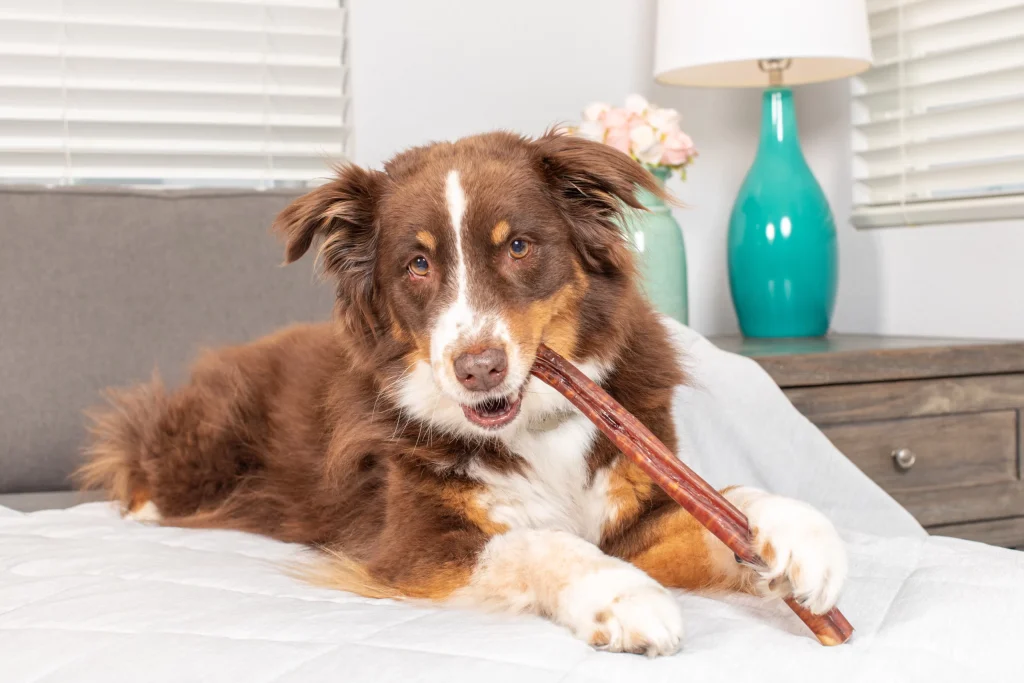Ever had one of those days where your dog just won’t chill? Maybe they’ve already had their walk, played fetch, barked at a bird outside, and they’re still pacing around like a furry tornado.
That’s usually when the bully stick comes out. And the second it does, boom, instant peace.

But if you’ve ever caught yourself thinking, “Can I give him another one?” or “Wait… how many of these is too many?,” you’re not alone.
Let’s talk about it. No fluff, no guilt. Just real talk from one dog lover to another.
Bully Sticks Are Awesome… But They’re Not Unlimited
Here’s the honest truth. As great as bully sticks are for chewing, cleaning teeth, and keeping your pup mentally busy, they shouldn’t be an all-day buffet.
One a day is the general rule. And that’s for a healthy adult dog with no tummy issues. But even then, size matters. A tiny Chihuahua and a beefy Lab are not going to handle the same chew the same way.
And if your dog is already getting a lot of treats, or tends to swallow chunks like a vacuum cleaner, then one stick every few days might be better.
So, Are Bully Sticks Actually Safe?
Yes, but with some common sense attached.
They’re definitely safer than rawhide. They’re fully digestible, and they don’t splinter like bones do. But dogs are still dogs, and some of them like to inhale instead of chew. That last inch or two of the stick? That’s where things can get risky.
Always supervise. Keep an eye out for any frantic chewing or gulping. If your dog has a sensitive stomach, maybe start with a short chew session and see how things go.
And if you’re dealing with a dog that has a history of pancreatitis or is on a low-fat diet, bully sticks might not be the treat of choice. Best to talk with your vet first.
Can Puppies Have Them Too?
They sure can, but age and size matter.
Puppies who are teething absolutely live for bully sticks. It gives them something to focus on other than your toes and table legs. But don’t just hand one over and walk away. Puppies are clumsy chewers, and they can bite off more than they can handle.
A good rule is: supervised chewing, short sessions, and choosing the right size stick. And honestly? Start slow. Let their little stomachs adjust before you let them go wild.
I’ve seen too many pup parents come in wondering why their puppy has soft stool, only to realize it’s from a treat overload. Puppies need balance.
What’s With That Funky Smell?
Okay, let’s not ignore the elephant in the room, or the stink in the air.
Some bully sticks smell… well, feral. That barnyard-meets-fish-market vibe? Yeah, it’s real. And totally normal. It comes from the drying process and the fact that these are all-natural animal parts. The less processed they are, the stinkier they can be.
If the smell bothers you (or your carpet), look for low-odor versions. Or toss them in the freezer before handing one over. It won’t kill the scent completely, but it takes the edge off. Plus, frozen sticks last longer. Win-win.
Rawhide vs. Bully Sticks, Not Even Close
If you’re still giving rawhide, now’s a good time to reconsider. Unlike bully sticks, rawhide isn’t fully digestible. Chunks can sit in a dog’s belly for days and cause serious blockages. It’s also often bleached or treated with weird chemicals. Not the vibe.
Bully sticks might be pricier, but they’re natural, digestible, and honestly just better for your dog’s health. Way less drama, and your dog gets the chewing satisfaction without the stomach risk.
Articles You Might Love
Tips for Smart Treating
Here’s a little cheat sheet I share with dog parents all the time:
- Stick to one bully stick per day, max.
- For small dogs or puppies, half a stick is plenty.
- Always supervise chew time. Seriously. Always.
- Don’t use them as a meal replacement.
- Store them in an airtight container, or better yet, your freezer.
- Skip if your dog has dietary restrictions or GI issues.
And don’t be afraid to take a bully stick away once it’s chewed down to a tiny nub. Better safe than sorry.
Real Talk: Not Every Dog Tolerates Them the Same
Some dogs chew politely, like little chew angels. Others chomp like they’re racing a clock.
And some dogs? They get runny poop, even from just one stick. That doesn’t mean bully sticks are bad. Just that every dog’s body handles them differently.
If your dog has a history of scarfing food or gobbling treats without chewing, consider a bully stick holder. It keeps the chew in place and slows them down a bit.
Final Thoughts From a Fellow Dog Lover
Look, we all want to treat our dogs. Especially when they’ve been extra good, or extra annoying and we just need five minutes of peace. And bully sticks can be a great way to do that.
But like with anything good in life, moderation is key. A bully stick isn’t a babysitter. It’s a bonus. A little chew-time joy, not a daily diet staple.
Your dog will love them. You’ll love the quiet. And as long as you’re keeping it smart and safe, you’re doing just fine.
How often do you give your dog bully sticks, and how long do they actually last before they’re gone?